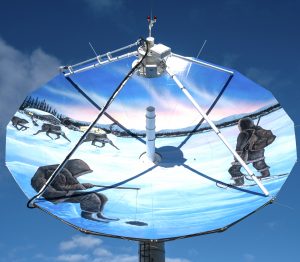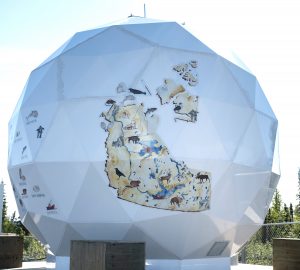June 22, 2019
In co-operation with NRCan operating the Inuvik Satellite Station Facility (ISSF) in Canada’s Northwest Territories, SSC celebrated Canada’s National Indigenous Peoples Day with the inauguration of the antenna art initiative at the ISSF.
Since established in 2010, Inuvik Satellite Station Facility (ISSF) has had close relations to its roots in the Canadian wilderness just above the Arctic Circle. To acknowledge the region’s original inhabitants, the station now adorns its antennas with a unique and colorful art show. The project “Antenna as Canvas” was initiated by The Canada Centre for Mapping and Earth Observation to engage the community of Inuvik and honor the local indigenous cultures Gwich’in, Inuvialuit, Métis as well as the town of Inuvik.
“We wanted to honor the indigenous cultures and their history, and to acknowledge the diversity of the people in Inuvik. This project started out as a Canada 150 project in 2017, and has since evolved into a project focused on engagement of the communities living in Inuvik through art. The result is what you see on these antennas,” said Prashant Shukle, Director-General of Canada Centre for Mapping and Earth Observation at Natural Resources Canada.
“Today SSC recognizes its long-term relationship with NRCan through the celebration of National Indigenous Peoples Day. We are honored to have these beautiful pieces of art welcome our customers, partners and employees to the ISSF and the greater Inuvik region”, said Dan White, EVP for Satellite Management Services in the Americas Region at SSC.
The two SSC antennas at the site are painted by the local artists Anick Jenks and Ron English. The latter has portrayed key elements of Métis culture in the Inuvik region. In this design, the infinity symbol represents key values of the Métis culture two circles joined together to represent the meeting of two cultures, as well as the immortality of the Métis nation.
“For SSC, there is a symbolic meaning to this art as our ground station solution Infinity offers coverage around the globe, connecting people and continents by enabling satellites to stay in contact with Earth,“ said Dan White.
For more info, visit https://www.canada.ca/en/natural-resources-canada/news/2019/06/inuvik-satellite-station-antenna-art-highlights-indigenous-life-and-culture.html
Photo Cred: Weronika Murray
June 22, 2019
In co-operation with NRCan operating the Inuvik Satellite Station Facility (ISSF) in Canada’s Northwest Territories, SSC celebrated Canada’s National Indigenous Peoples Day with the inauguration of the antenna art initiative at the ISSF.
Since established in 2010, Inuvik Satellite Station Facility (ISSF) has had close relations to its roots in the Canadian wilderness just above the Arctic Circle. To acknowledge the region’s original inhabitants, the station now adorns its antennas with a unique and colorful art show. The project “Antenna as Canvas” was initiated by The Canada Centre for Mapping and Earth Observation to engage the community of Inuvik and honor the local indigenous cultures Gwich’in, Inuvialuit, Métis as well as the town of Inuvik.
“We wanted to honor the indigenous cultures and their history, and to acknowledge the diversity of the people in Inuvik. This project started out as a Canada 150 project in 2017, and has since evolved into a project focused on engagement of the communities living in Inuvik through art. The result is what you see on these antennas,” said Prashant Shukle, Director-General of Canada Centre for Mapping and Earth Observation at Natural Resources Canada.
“Today SSC recognizes its long-term relationship with NRCan through the celebration of National Indigenous Peoples Day. We are honored to have these beautiful pieces of art welcome our customers, partners and employees to the ISSF and the greater Inuvik region”, said Dan White, EVP for Satellite Management Services in the Americas Region at SSC.
The two SSC antennas at the site are painted by the local artists Anick Jenks and Ron English. The latter has portrayed key elements of Métis culture in the Inuvik region. In this design, the infinity symbol represents key values of the Métis culture two circles joined together to represent the meeting of two cultures, as well as the immortality of the Métis nation.
“For SSC, there is a symbolic meaning to this art as our ground station solution Infinity offers coverage around the globe, connecting people and continents by enabling satellites to stay in contact with Earth,“ said Dan White.
For more info, visit https://www.canada.ca/en/natural-resources-canada/news/2019/06/inuvik-satellite-station-antenna-art-highlights-indigenous-life-and-culture.html
Photo Cred: Weronika Murray

The design of the first SSC antenna, painted by Anick Jenks, reflects the vibrancy of the community of Inuvik and is intended to welcome the world to the Inuvik Satellite Station Facility. It depicts Inuvik’s iconic “smartie” houses, the midnight sun, ravens and in the foreground, the Mackenzie river.

The design of the second SSC antenna, painted by Ron English, depicts key elements of Métis culture in the Inuvik region. In this design, the infinity symbol represents key values of the Métis culture two circles joined together to represent the meeting of two cultures, as well as the immortality of the Métis nation. For SSC, there is a symbolic meaning to this as our ground station solution Infinity offers coverage around the globe, connecting people and continents by enabling satellites to stay in contact with the Earth.

This Gwich’in winter scene depicts the traditional way of life of the Gwich’in people – hunting, trapping, and fishing – which to this day remain significant to the Gwich’in economy and way of life.
Artist: Ronnie Simon

This Inuvialuit design depicts the Inuit blanket toss, a traditional activity used to scout for game or to scan the horizon. A large group of “pullers” raise and lower the blanket, tossing the man or woman into the air.
Artist: Sheree McLeod

The C-Core radome has 24 pieces of artwork depicting wildlife, cultural symbols and a map of the Northwest Territories.
Artist: East Three High School Art Club

